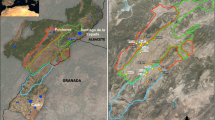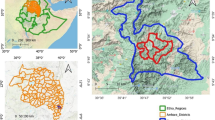Abstract
In the early 1960s, Robert Netting described households in the Kofyar homeland in Nigeria and explained their size, composition, and other characteristics as adjustments to agrarian ecology. Household changes attending movement to a frontier were analyzed in the same framework. By the 1980s, the economic rationale for homeland farming had all but disappeared, and some villages seemed on the verge of abandonment. Yet deliberate strategies for preserving homeland settlements had prevented abandonment. The demographic characteristics and household composition in the homeland now provide a window into a wholly different set of processes than what Netting described 30 years ago. Home settlement is kept viable as a facility to support ethnic identity and to attract government resources. Beneath superficial similarities are profound changes in the nature of the household and factors shaping it, reflecting the changed rationale for keeping the home fires burning.
Similar content being viewed by others
REFERENCES
Adams, W. Y. (1980). The dead community: Perspectives from the past. In Gallaher, A., Jr., and Padfield, H. (eds), The Dying Community. University of New Mexico Press, Albuquerque, pp. 23–53.
Akinyele, R. T. (1996). States creation in Nigeria: The Willink report in retrospect. African Studies Review 39: 71–94.
Andrae, G., and Beckman, B. (1985). The Wheat Trap: Bread and Underdevelopment in Nigeria. Zed Books, London.
Appadurai, A. (1988). Putting hierarchy in its place. Cultural Anthropology 3: 36–49.
Berry, S. (1985). Fathers Work for Their Sons: Accumulation, Mobility, and Class Formation in an Extended Yoruba Community. University of California Press, Berkeley.
Boserup, E. (1965). The Conditions of Agricultural Growth. Aldine, New York.
Evans-Pritchard, E. E. (1940). The Nuer. Oxford University Press, New York.
Findlay, R. L. (1945). The Dimmuk and their neighbors. Farm and Forest 6: 137–145.
Joseph, R. A. (1987) Democracy and Prebendal Politics in Nigeria: The Rise and Fall of the Second Republic. Cambridge University Press, Cambridge.
JosProF (Jos Provincial Files), National Archives Kaduna, file 2097a “Sabon Gida: An Experiment in Resettlement,” 1949.
Kirk-Greene, A., and Rimmer, D. (1981). Nigeria Since 1970: A Political and Economic Outline. Hodder and Stoughton, London.
Laslett, P. (1972). Introduction: The history of the family. In Laslett, P., and Wall, R. (eds.), Household and Family in Past Time. Cambridge University Press, Cambridge, pp. 1–89.
Linares, O. F. (1983). Social, spatial and temporal relations: Diola villages in archaeological perspective. In Vogt, E. Z., and Leventhal, R. (eds.), Prehistoric Settlement Patterns: Essays in Honor of Gordon R. Willey. University of New Mexico Press/Harvard University, Cambridge, pp. 129–163.
Malkki, L. (1992). National Geographic: The rooting of peoples and the territorialization of national identity among scholars and refugees. Cultural Anthropology 7: 24–44.
Netting, R. McC. (1965). Household organization and intensive agriculture: The Kofyar case. Africa 35: 422–429.
Netting, R. McC. (1968). Hill Farmers of Nigeria: Cultural Ecology of the Kofyar of the Jos Plateau. University of Washington Press, Seattle.
Netting, R. McC. (1969). Ecosystems in process: A comparative study of change in two West African societies. National Museum of Canada Bulletin 230: 102–112.
Netting, R. McC. (1987). Clashing cultures, clashing symbols: Histories and meanings of the Latok War. Ethnohistory 34: 352–380.
Netting, R. McC. (1993). Smallholders, Householders: Farm Families and the Ecology of Intensive, Sustainable Agriculture. Stanford University Press, Stanford.
Netting, R. McC., Stone, M. P., and Stone, G. D. (1989). Kofyar cash cropping: Choice and change in indigenous agricultural development. Human Ecology 17: 299–319.
Netting, R. McC., Stone, G. D., and Stone, M. P. (1993). Agricultural expansion, intensification, and market participation among the Kofyar, Jos Plateau, Nigeria. In Turner, B. L., II, Hyden, G., and Kates, R. (eds.), Population Growth and Agricultural Change in Africa. Univ. of Florida Press, Gainesville, pp. 206–249.
Nnoli, O. (1978). Ethnic Politics in Nigeria. Fourth Dimension Publisher, Enugu.
Nyerges, A. E. (1992). The ecology of wealth-in-people: Agriculture, settlement and society on the perpetual frontier. American Anthropologist 94: 860–881.
Rowling, C. W. (1946). Report on Land Tenure in Plateau Province. National Archives Kaduna, File 997/S. 1.
Stocking, M. A. (1996) Soil erosion. In Adams, W. M., Goudie, A. S., and Orme, A. R. (eds.), The Physical Geography of Africa. Oxford University Press, Oxford, pp. 326–341.
Stone, G. D. (1992). Social distance, spatial relations, and agricultural production among the Kofyar of Namu District, Plateau State, Nigeria. Journal of Anthropological Archaeology 11: 152–172.
Stone, G. D. (1996). Settlement Ecology: The Social and Spatial Organization of Kofyar Agriculture. University of Arizona Press, Tucson.
Stone, G. D., Johnson-Stone, M. P., and Netting, R. M. (1984). Household variability and inequality in Kofyar subsistence and cash-cropping economies. Journal of Anthropological Research 40: 90–108.
Stone, G. D., Netting, R. McC., and Stone, M. P. (1990). Seasonality, labor scheduling and agricultural intensification in the Nigerian savanna. American Anthropologist 92: 7–24.
Stone, M. P. (1988). Women, Work and Marriage: A Restudy of the Nigerian Kofyar. University Microfilms, Ann Arbor.
Stone, M. P., Stone, G. D., and Netting, R. McC. (1995). The sexual division of labor in Kofyar agriculture. American Ethnologist 22: 165–186.
Uchendu, V. C. (1995). The dilemma of ethnicity and polity primacy in Black Africa. In Romanucci-Ross, L., and De Vos, G. A. (eds.), Ethnic Identity: Creation, Conflict and Accommodation (3rd Ed.). Altamira Press, Walnut Creek, pp. 125–135.
Wilk, R. R., and Netting, R. McC. (1984). Households: Changing Forms and Functions. In Netting, R. McC. Wilk, R. R., and Arnould, E. J. (eds.), Households: Comparative and Historical Studies of the Domestic Group. University of California Press, Berkely, pp. 1–28.
Wunsch, J. S. and Olowu, D. (1996/97). Regime transformation from below: Decentralization, local governance, and democraticre form in Nigeria. Studies in Comparative International Development 31(4): 66–82.
Rights and permissions
About this article
Cite this article
Stone, G.D. Keeping the Home Fires Burning: The Changed Nature of Householding in the Kofyar Homeland. Human Ecology 26, 239–265 (1998). https://doi.org/10.1023/A:1018718923793
Issue Date:
DOI: https://doi.org/10.1023/A:1018718923793




